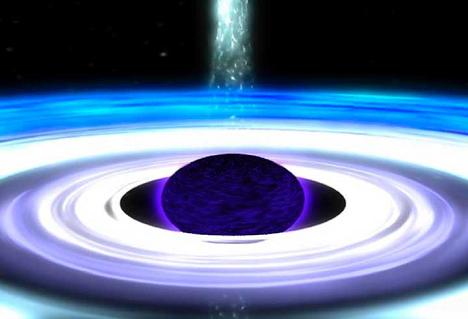Astronomers from the Institute of Astronomy (IoA) in Cambridge, England observed a mass of matter in the core of a galaxy, 100 million light years away from Earth, orbiting a supermassive black hole 4 times on its way to destruction.
Ariel Eisenhandler, Israel Astronomical Society
Astronomers from the Institute of Astronomy (IoA) in Cambridge, England observed a mass of matter in the core of a galaxy, 100 million light years away from Earth, orbiting a supermassive black hole 4 times on its way to destruction. The distance of the material from the black hole was roughly the same distance as Kdhua's from the Sun and it "swallowed" it in only a quarter of a day, due to the black hole's enormous gravitational force. By tracking the "Doomed Orbit" the astronomers were able to calculate the mass of the black hole: 10 to 50 solar masses.
Initial observation: Scientists have been able to piece together the journey of a chunk of matter that was decimated as it circled a black hole four times. Their process provides a new method for measuring the mass of a black hole, allowing Einstein's theory of gravity to be tested at levels many thought impossible.
A team led by Dr. Kazushi Iwasawa from the Institute of Astronomy in Cambridge, England followed the path of hot gas for an entire day as it wrapped around a supermassive black hole, at a distance similar to that of the Sun. The lap, accelerated by the black hole's extreme gravity, took a quarter of a day instead of a year. The scientists were able to calculate the mass of the black hole by inserting the measurements of the light energy, its distance from the black hole and the time it took to orbit the black hole - a combination of Einstein's general theory of relativity and good old-fashioned Kepler physics.
Iwasawa and his colleagues at the IoA, Dr. Giovanni Miniutti, presented the finding today (10/09/04) at a web press conference held in New Orleans at a meeting of the High Energy Astrophysical Society of the American Astronomical Society. Dr. Andrew Fabian joins them in an article published in the upcoming edition of "Monthly Notices" of the Royal Astronomical Society. The information came from the European Space Agency's Newton XMM observatory.
The team studied a galaxy called 3516 NGC, which is 100 million light-years away from Earth and is in the region of the constellation Ursa Major, home of the Big Dipper or the Plow. It is assumed that at the core of this galaxy resides a supermassive black hole. In these central regions, gas glows with X-rays after it is heated to a temperature of millions of degrees due to the enormous gravitational force of the black hole.
The Newtonian XMM observatory captured spectral features from the light surrounding the black hole, which are displayed on a spectrograph (a device for recording or photographing a spectrum) with spikes indicating certain energy levels, much like the jagged lines of a cardiograph (a device for recording the heart's action). During the day-long observation, the XMM captured an outburst of "passionate" gas that surrounded the black hole and wrapped around it 4 times. This was the critical piece of information needed to measure the mass of the black hole. The scientists already knew the distance of the gas from the black hole by its spectral characteristics (the rate of gravitational redshift or energy loss detected by the spectral line, related to how close an object is to a black hole). With the help of distance and lap time data, the scientists can arrive at mass measurements - between 10 and 50 solar masses, in accordance with values obtained by other techniques.
While the calculation is clear, the analysis to understand the cycle time of an X-ray burst is new and complex. Basically, the scientists noticed the cycle repeating four times: modulation (-regulation) of the light intensity accompanied by oscillation (- oscillation, shaking) of the light energy. The observed energy and cycle fit the profile of light that is redshifted due to gravity (gravity stealing energy) or deflected by the Doppler effect (gain and loss in energy when material in orbit moves towards us or away from us).
The analysis technique implies, to the surprise of this team of scientists, that the current generation of X-ray observations can give a significant achievement in measuring the masses of black holes, combining long observations and black hole systems with long-lasting eruptions.
Based on this information, finder missions such as Constellation-X or XEUS can go further in testing Einstein's mathematics in the Extreme Gravity Laboratory.

